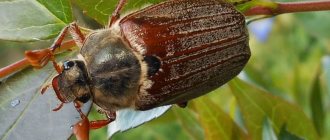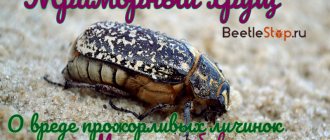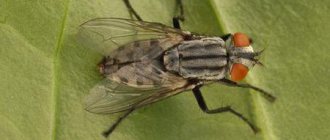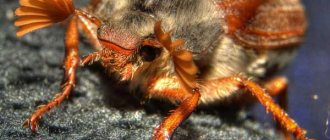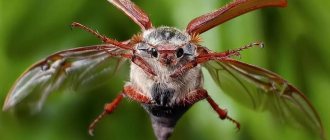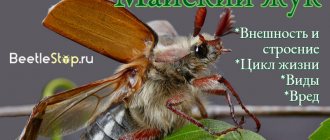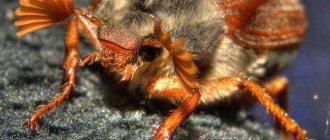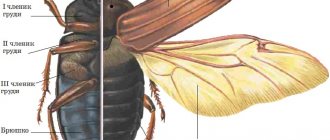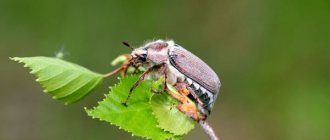Chafer
- a large insect, more than 3 cm in size. Its body looks like an elongated hazelnut, since the elytra are nut-colored. The body is covered with dense hairs. The insect has 6 brown legs and a black cephalothorax. Males are distinguished from females by a special formation on the antennae - a club consisting of plates - hence the name of the genus lamellar.
Scientists still cannot understand how the cockchafer flies, since the cockchafer
has small and weak wings. However, beetles move quickly through the air.
Pests are not only beetles, but also their larvae, which are popularly called beetles. The larva looks like a white, thick caterpillar with six small legs on the front of its body. The back of the body is dark in color, with two rows of small dark spots on the sides. The head is brown or reddish in color.
Sometimes the green bronze beetle, a large beetle with a bright green body, is mistaken for the May beetle. Despite the fact that the green bronze fly also feeds on plants, it causes almost no harm to agriculture. In addition, the beetle is listed in the Red Book, so it cannot be destroyed. You can keep bronze dogs at home and watch their interesting behavior.
Lacewing.
- They eat the leaves of almost all deciduous trees and shrubs (oak, birch, poplar, maple, willow, and fruit trees - pear, apple, plum), and do not even refuse pine and larch.
- In everything good there is bad and in everything bad there is good. The main thing is to present it properly. !
- they have a lot of protein, tear off the wings before frying and enjoy your meal!
- Life underground
- Chafer beetles are one of the first heralds of spring. As soon as the sun warms the ground in the fields and meadows, the beetle crawls out of it after winter sleep and, spreading its wings, sets off in flight. The purpose of its flight is to search for food, because during hibernation the beetle does not feed on anything.
- Small hairs or hair-like scales grow throughout the body. Their length varies depending on the parts of the body. For example, the hairs on the chest are yellow, long and dense. And on the abdomen there are hairs, both short and long, growing sparsely.
Recommended articles: indasad.ru
To the beginning
May beetle diet
What the cockchafer eats depends on its habitat. The habitat of this representative of the order Coleoptera occupies a vast territory. The May Khrushchev can be found in central Russia from the Leningrad region to Western Siberia and the Altai Territory, as well as on the Crimean Peninsula, the Caucasus, and European countries. And wherever he lives, he has an excellent appetite.
Adult cockchafers readily eat the foliage and needles of trees such as:
- maple;
- pine;
- spruce;
- Linden;
- birch;
- alder;
- cherry;
- plum;
- honeysuckle;
- grape;
- rosehip and many others.
Diet of the cockchafer
Such a wide diet allows the chafer to feel at ease in any region. Close relatives of the May beetle are the June beetle and the bronze beetle, which many mistakenly call the green May beetle. All these representatives of the same family in nature feed on the same plants and cause irreparable harm to the fauna.
Appearance of the May Khrushchev
The May beetle is a genus of Coleoptera insects, family – lamellar beetles. These are quite large insects up to 32 millimeters in size. The body is oblong-oval. The head is small, the mouthparts are of a gnawing type.
The main difference between a female and a male is the size and structure of the antennae. Males are characterized by the presence of 7 plates, while females have only six. Plus, the antennal plates of the female are almost half the size of those of the opposite sex.
There are two most common types of insects in Russia:
— Western May Khrushchev;
- Eastern May Khrushchev.
The western species lives mainly in the west of the Eurasian continent. The lower body, limbs and cephalothorax are black.
The range of the eastern May beetle extends from Yakutia and Beijing to Odessa and Zaporozhye in the west. Legs and antennae are red-brown. The cephalothorax can be colored from black to red-brown. Oriental Khrushchev causes enormous damage to young coniferous plantations in Siberia. By destroying the roots of young pines, the beetle larvae lead to their mass death.
The larvae of both species have a similar structure. The color is white, the body shape is most often C-shaped. The head is brown with a formed gnawing apparatus of yellow-brown color. There are three pairs of limbs, no pseudopods.
Living spring medicine
May beetles do not reproduce as quickly as Colorado beetles, but they can also cause damage to forest plantations.
May beetles with great appetite eat leaves, buds and ovaries of trees, which causes photosynthesis to decrease, the plant to weaken and may even die.
The larvae of the cockchafer feed on the roots of trees and shrubs, which can also cause them irreparable harm with serious consequences. In addition, even through slightly damaged roots, pathogenic microbes can penetrate into the tree.
However, there are some benefits from cockchafers. True, official medicine does not use them, but village healers learned to make infusions, tinctures and other drugs from them much earlier than from Colorado beetles.
No one has studied the chemical composition and healing properties of cockchafers, but if you consider that they feed on fresh, green leaves, flowers and shoots of trees and shrubs, we can conclude that their tissues accumulate many useful and unique substances, which are used in traditional medicine .
To prepare infusions, tinctures and other potions, beetles are collected manually - for this, a blanket or sheet is spread under the tree, and the beetles are shaken off the branches. Next, the raw materials are used for their own purposes.
Since cockchafers are collected only during active flight - 1-2 months a year, the raw materials can be prepared for future use - dried in the oven at a temperature of 50-60 degrees and ground in a coffee grinder.
Recipe 1.
Folk remedy for radiculitis from the cockchafer. Collect and dry the cockchafers, replace the dough with rye flour and add beetle powder. You will need a little dough - for 1 flatbread.
The cake will need to be applied to the sore spot on the back, covered with cellophane and a warm cloth. After 40 minutes, remove the cake. Heat the vegetable oil in a steam bath in advance.
When you remove the cake, you will see that many small blisters have formed underneath. Pierce them with a needle or pin, remembering to soak the “tool” in oil before each puncture. The following procedure can be done after the code at the site of the blisters has dried and healed. Sometimes 1-2 such procedures are enough to cure radiculitis.
Recipe 2.
May beetle against pulmonary tuberculosis. To prepare the medicine, you need to collect the beetles early in the morning, before sunrise; you will need 1 glass of them. You need to crush the beetles with your hands or a wooden masher, and then add 1 cup of rye flour to the pulp and make a flat cake. The cake needs to be placed on the right side of the back and tied with a scarf or handkerchief so that it does not fall off - this procedure is done all night.
In the morning, remove the cake - under it there should be a large blister with a lot of pus. There is no need to pierce it - the pus will drain out on its own. To cure pulmonary tuberculosis, 1 procedure is enough.
Recipe 3.
Alcohol tincture of chafers for uterine cancer. Take 24 cockchafers, dry them in the shade, crush them, put them in a glass jar and pour 500 ml of vodka. Leave in the sun for 7 days, then strain.
You need to drink 1 tbsp of tincture. in the morning on an empty stomach. At the same time as taking the tincture, you need to douche with a decoction of celandine.
Recipe 4.
Alcohol tincture of cockchafers for rheumatism. Collect ½ half-liter jar of Maybugs, fill with vodka to the brim. Place the jar in a dark place for 10 days. Then strain and use for rubbing.
With a tincture of beetles, you can treat abscesses, boils, fistulas, corns, old wounds, irritations and rashes on the skin, and ulcers.
Recipe 5.
Wounds from dog bites, including rabid ones, should be sprinkled with dried, crushed chafer powder. At the same time, you need to drink a decoction of yarrow. A person bitten by a rabid dog was given powder from 1 dried May beetle, which must be washed down with bread kvass.
Recipe 6.
Honey infused with chafers is used to heal wounds, burns and ulcers.
Video addition:
Harm of the cockchafer
The question of the dangers and benefits of the cockchafer is in the first place for people whose activities are related to agriculture. May beetle is another name for a beetle that belongs to the Coleoptera insects. They are excellent fliers and can fly 20 km or more. This mobility provides the beetle with a wide choice of food. The favorite delicacy of an adult insect is the young leaves of trees and shrubs, their inflorescences and even needles.
When wondering whether cockchafers are poisonous, you can safely answer in the negative. The only advantage of this pest is that it does not have the ability to sting or release toxic substances.
Those who do not know whether the cockchafer is dangerous for humans may find its large size and roar during flight terrifying. The insects themselves are not predators; they are attracted to plant foods. The life cycle of an adult lasts only 1.5 - 2 months. The main damage is caused by its larva.
Chafer
Adult nutrition
The mass appearance of the May beetle in the form of an adult individual - imago, is timed to coincide with the beginning of flowering and the appearance of young foliage on the trees. In May, the beetle crawls out of the soil after pupation and immediately begins to eat. In the eastern and northern regions of our country, the main delicacies for Khrushchev are:
- young foliage of aspen, poplar, linden, maple;
- birch and alder catkins;
- needles of larch, spruce, pine;
- inflorescences of apple, cherry, plum trees.
Western beetleworm is characterized by attacks on plants growing in the southern regions of Europe: grapes, walnuts, hazelnuts, oak, chestnut, beech, acacia and others. For summer residents, it is well known why the cockchafer is harmful to the garden. Gooseberry and blackcurrant bushes can attract insects as another source of food. After a thorough meal and mating, female beetles lay eggs in the soil, from which a new stage of the insect, the larva, emerges after a few days.
Harm to the larvae
The inconspicuous light yellow worm is harmless in the first months of its existence. It still has underdeveloped jaws, and it can eat humus, humus, and small grass roots. The real harm to the cockchafer larva becomes noticeable in the second year of its life. After a successful winter in the deeper layers of the soil, the caterpillar moults and becomes larger. Its jaws can handle the roots of garden crops, such as:
Being in the larval stage, the beetle is especially dangerous in the garden. Considering the large number of caterpillars, you can imagine the damage they can cause. In the third year of their life, they molt again and become even more voracious. Now they are tough on the roots of young trees.
Chafer
One May beetle larva, in its 3rd year of life, can destroy the roots of a two-year-old tree in one day.
Having successfully overwintered the next winter, in the fourth or fifth year of its life the larva pupates and degenerates into an adult insect by the next spring. Such a long life cycle of the beetle makes it one of the most dangerous pests of nature.
Benefits of the summer beetle
It is difficult to underestimate the destructive activity of this pest in relation to trees and other plants. Khrushchev does not perform any useful actions in its entire life, except for its use in fishing.
Avid fishermen and just hobbyists often use fatty caterpillars as bait on the hook of a fishing rod. This bait is attractive to many predator fish:
Using an adult is no less successful for attracting fish. You just need to throw a few beetles into the water and wait until they become dinner for your future catch. Then you can safely throw the rod into the feeding area. It is recommended to put the beetle on a hook. The insect will flounder in the water and attract fish.
Collecting bait is carried out as follows:
- Adult pests can be collected by hand by shaking tree branches.
- Many individuals are easy to find near street lamps. In the twilight hours, they are attracted by the bright light of the lamp, which, when burned, causes the beetles to fall to the ground.
- Extracting larvae will not take the fisherman much time if you dig up the top layer of soil in the garden or vegetable garden between the beds. The fatty bait is collected by hand into a jar with soil.
This method of using pests can significantly reduce their number within your summer cottage or garden. But it is very difficult to get rid of all the culprits of plant death. Only by applying an integrated approach to their destruction can the majority of garden crops be saved.
With the onset of the first warm days, many people who are ardent fans of gardens and vegetable gardens begin to worry about such an issue as the siege of the site and plants by cockchafers. Many people are completely unaware of whether this insect can cause any significant harm to crops and plants and somehow affect humans. In fact, the cockchafer is a truly unique natural creation! Its flight defies any of the laws of aerodynamics.
Let's take a little break! We look at modern styles and models of wristwatches here - watches for women and men, children's and sports watches, live with the times!
Engineers believe that such a cockchafer is not at all adapted to flight functions. In other words, the cockchafer was not created by nature to fly. After all, the body of this insect is too thick, and the wings are very small in comparison. But nevertheless, when flying, the cockchafer is capable of reaching speeds close to three meters per second.
There are periods during the year when there are a lot of May beetles in vegetable gardens and orchards. At other times, he cannot be found at all. According to scientists, surges in the number of cockchafers are associated with weather conditions. However, their number is influenced to a greater extent by the increase in the number of their natural enemies in the form of owls, cuckoo beetles, starlings, as well as birds such as the oriole.
May beetle - benefit or harm of the insect?
The number of cockchafers can be affected by the accumulation of garbage heaps and large landfills, which, as a result of the “efforts” of city residents, often appear in clearings and suburban forests. In fact, each of these heaps acts as an excellent incubator for the reproduction of cockchafers. In a landfill and in a garbage heap, almost ideal conditions are created for this insect to lay its eggs, and then caterpillars develop from them.
Nature has long ago invented its own mechanisms with the help of which, without human intervention, it is possible to regulate the number of cockchafers within each season. However, sometimes some anomalies may occur. At the same time, there may be too many May beetles. There are periods when gardens and vegetable gardens are literally besieged by hordes of these insects.
In the middle zone of the country, an invasion of cockchafers can even destroy an entire forest area during the flight period. After all, the cockchafer feeds on almost everything: young leaves, tree buds, shoots, shoots on bushes, etc. It is during the time when plants are flowering and buds are opening that adult cockchafers are capable of causing significant harm.
Traditional methods of combating the cockchafer and its larvae
The cockchafer and its larvae are long-standing enemies of all gardeners. Therefore, today gardeners have come up with a large number of ways to get rid of these pests using improvised means.
1. The easiest way is to collect pests manually. Of course, it can be applied exclusively to adult beetles, because collecting the larvae by hand will be very, very problematic. If a gardener discovers that some low-growing bushes and trees have been attacked by the cockchafer, he can collect the insects with his hands, after wearing thick gloves. It is better to collect beetles in a tall three-liter jar. When all visible beetles have been collected, they must be doused with boiling water and then disposed of.
Tall plantings should be cleared of beetles in a slightly different way. Thick plastic film should be spread under trees and bushes where uninvited guests live. In the early morning, when the beetles are still sleeping, the plantings should be shaken as hard as they can so that the insects fall on the spread film. Then the cockchafers also need to be doused with boiling water and disposed of.
2. If the gardener cannot collect the larvae at a time when they are already actively damaging the garden, then he should take care of this in advance
During the spring preparation period, when summer residents are digging up their garden plot, they should be careful and pay attention to the presence of white larvae resembling worms in the soil. If any are found, they should be collected manually and disposed of.
3. Moles, as well as hedgehogs, are not averse to eating the larvae of the cockchafer. Therefore, if a summer resident finds mole passages on his site, he should not fill them up. These mammals will help gardeners in the fight against the May pest.
4. Many gardeners strive to destroy beetles during their active breeding period. It is known that males are very fond of bright light. This fact can be used to catch males and prevent beetles from flooding the garden with larvae. This is quite simple to do: you need to stretch a sheet between two poles or trees, and install a fluorescent lamp behind it and turn it on. The bright light will attract males, and they will fly from different parts of the garden into a kind of trap. When there are quite a lot of insects, the sheet is rolled up into a ball and then set on fire.
5. The faithful enemies of adult cockchafers are starlings. These birds are not averse to eating insects. But to attract birds to your site, you need to install birdhouses.
6. An excellent way to combat May beetle larvae is to use onion solution. You can prepare it using only vegetable peels. To do this, fill the bucket a third with husks and then fill it with water. Infuse the solution for five to seven days. Onion solution should be sold throughout the growing season. The best option is to use the infusion at a time when the soil has already warmed up quite well and the larvae are located at a fairly close distance to the surface of the earth.
The cockchafer is an insidious insect, but it is not capable of causing enormous damage to the garden and vegetable garden, as its larvae can do. Therefore, in the fight against Khrushchev, one should not forget about preventive measures, namely:
1. Don’t forget to add a thick layer of mulch. Wood shavings, crushed bark or chopped straw can be used as mulch.
2. Do not forget to add white (chlorine-containing substance) during the autumn digging of the garden.
3. We should not forget that the cockchafer can suddenly appear in any garden. Therefore, it is better to always be on guard in order to repel the May Khrushchev at the right time!
Date: 06/28/2015.
Getting rid of Khrushchev
Physical removal
- Shake them off the trees in the morning, when the beetles are frozen, and destroy them by mechanical force.
- Regularly dig up tree trunk circles. All larvae must be selected manually.
- Leaves under trees should be burned.
Light traps
At night, the lantern is lit. A container of water mixed with a small amount of kerosene is placed under it. Insects attracted by the light will hit the lamp body and fall down. As an option, you can place a basin coated with grease or spread newspapers covered with long-drying glue. During the night, a considerable number of insects will gather in such traps, which will be burned or destroyed in some other way.
Biological method
Set up a house on your site for starlings or rooks. These birds love to feast on large beetles, which are a source of huge amounts of nutrients. Where these birds live, there is no place for Khrushchev. It is known that a pair of starlings, during the period of raising chicks, consumes and feeds to their offspring up to 8,000 adults and their larvae.
Chemicals
Against soil-dwelling pests, such as cockchafers, the modern market offers a whole range of chemicals of the insecticidal group:
- "Fix it";
- "Zemlin";
- "Aktara";
- "Bazudin";
Also, the Ukrainian-made Antikhrushch pesticide enjoys positive feedback from consumers.
Ways to combat cockchafer larvae
Every year new species appear that quickly become accustomed to the chemicals offered for control. It is possible to reduce losses from their actions to minimal values only by using all known methods and advice. The difficulty of controlling the pest is due to the lack of an effective drug that kills it and the inability to treat large areas with existing means.
Therefore, different methods of control are used at different stages of insect development.
Collection of larvae by hand. They can only be discovered for destruction when digging up the soil.
It is important to know that in open places pupation occurs in earth layers at a depth of up to 1 m. In spring they move to the layer where the maximum number of roots is located
As soon as the soil begins to dry out, the larvae go deeper. It is difficult to get into the soil layers at great depths, so it is impossible to completely get rid of the pest in this way. Sodding of the soil. Using information about intolerance to high nitrogen content in the soil, experts recommend creating dense lawns from plants capable of accumulating nitrogen in their root system. These include white clover. Its roots contain bacteria that absorb nitrogen, which is used for protein synthesis. Such soil becomes unpalatable for the larvae. It’s just that spring fertilizing with nitrogen fertilizers does not have such an effect. Attracting animals and birds. Birds provide great assistance in destroying adult beetles. This is the primary delicacy for rooks. Starlings find larvae for their chicks. Birdhouses are built to attract birds. Hedgehogs love to eat larvae and beetles. Therefore, if the owner manages to lure them, leaving, for example, food on his site, they can destroy the beetle almost completely.
Signs of strawberry damage
May beetle larvae parasitize throughout the warm season. A sign of a pest on strawberries is:
- growth slowdown;
- lack of flowers, berries;
- withered leaves;
- blackened stems.
When a site is massively infected, almost all bushes become damaged. Strawberry yields decrease and plants die.
You can find the beetle larva when digging up the soil in the garden bed - in the rows, around the plant. There is also one of the most effective methods to detect the parasite immediately. Water the strawberry bush, carefully dig it up, carefully examine the roots and the soil in the hole. The larva of the cockchafer is white and large, so it is easy to distinguish it from other strawberry pests.
What does the cockchafer and its larvae look like?
The length does not exceed 3 cm, the body is elongated. Elytrae of the insect pest are usually brown in color. There are many short villi along the entire length of the body. Sexual dimorphism of pests is represented in the formation on the antennae. The wings are poorly developed, however, it flies quite well. When flying it makes a loud noise. The movement speed is quite high for its size.
Harm to fruit crops is caused not only by mature individuals, but also by undergrown plants. A typical popular name for underdeveloped insects that have not undergone morphological changes is Khrushchev. They are similar in appearance to a regular caterpillar, with 3 pairs of legs on the front of the body. Khrushchev is characterized by the following features:
- The head is red, small in size, round in shape. It has quite powerful jaws, thanks to the properties of which the beetle eats up root crops;
- the back of the body is dark, often brown. This property is ensured by large deposition of feces in the intestines.
Description of the insect
We all know what a cockchafer looks like since childhood.
Some saw them live, and others saw them in pictures for the fairy tale “Thumbelina.” The body of the beetle is barrel-shaped, black or brown-brown, elongated at the rear. The length reaches 3.5 - 4 cm. It is distinguished from other insects by antennae with long bristles.
The larva of the cockchafer, also known as the furrow beetle, has a thick white body, bent in the middle, three pairs of legs and a large brown head.
The beetle's pupa is more similar to the adult, but with shorter wings.
What crops does the cockchafer damage?
Adult chafers appear in early May when warm weather sets in. During this period, they cause harm by feeding on young leaves and flowers of all garden, park and forest plants. Cold weather causes imago torpor and even death when spring frosts return. Adults are most harmed in the spring when they emerge from the pupa. The main concern of an adult insect is to leave offspring. For 1-2 months a year, adult female cockchafers feed intensively and lay eggs.
4-6 weeks after the imago emerges, the next generation of larvae hatches from the eggs, and the larvae of previous years of hatching are activated. They live in the soil for up to 4 years, going through 6 stages of maturation. They constantly migrate in the vertical soil horizon. In winter they go to the lower horizons up to 50 cm, and in spring they return to the root layer with the soil warming up to +10..+15°C. The larvae of the May beetle throughout the entire period of their life, except for the pupal stage and the period of hibernation, constantly gnaw on everything that is in the soil. Unlike adult May beetles, they gnaw at the roots of weeds, vegetable and garden plants, mature garden and forest trees, berry beds, shrubs and other types of plants. The larvae gnaw the roots of strawberries/strawberries, black and other types of currants. Especially a lot of them gather at the roots of apple and cherry trees. In parks and forest edges, cockchafer larvae settle at the roots of aspen, birch, cedar, spruce and other plants. Observations have established that a 3-year-old larva is capable of destroying the root system of a 2-year-old pine in 1 day, and a 2-year-old larva will feed on the roots of the tree for a whole week. There is currently a 10-year hiatus in flight. New cockchafer larvae hatch from the laid eggs, previously born ones grow up, and the larvae reproduce intensively in soil conditions.
May beetle larva. a-evans
Signs of plant infection
Adults feed mainly on leaves. They eat or make holes in leaf blades, damage buds, ovaries and flowers. Because of this, the process of photosynthesis in plants is disrupted, they weaken and wither.
The larvae cause more harm; they are voracious and damage plant roots; 3–5 of them can completely destroy the root system of a young tree. Even minor damage makes the plant vulnerable to pathogens. Young plants wither and are easily removed from the ground, and adult specimens, having a reserve of vitality, do not die, but slow down their development. Yields of vegetables and fruits are reduced, side shoots on trees do not ripen well.
Adult insects and larvae are easy to detect on above-ground parts and in the soil and make sure that they are the cause of crop damage.
